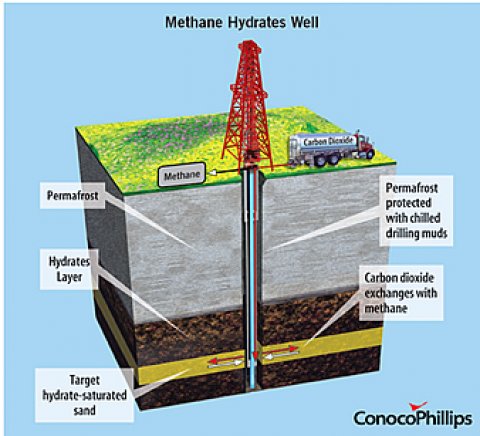Arctic/Alaska North Slope Field Studies
Since 2001, DOE has conducted field trials of exploration and production technology in the Alaska North Slope. Although Alaska methane hydrate resources are smaller than marine deposits and currently lack outlets to commercial markets, Alaska provides an excellent laboratory to study E&P technology. The research also has implications for various Alaska resources, including potential gas hydrate resources for local communities, conventional "stranded" gas, as well as Alaska’s large unconventional oil resources. The hydrate deposits have been delineated in the process of developing underlying oil fields, and drilling costs are much lower than offshore.
DOE-BP Project
In 2002, DOE initiated a project with BP that has been conducted in collaboration with the U.S. Geological Survey. The project used existing seismic and well data to define 14 drilling prospects in the Milne Point area that were projected to contain 600 billion cubic feet of gas in place. In early 2007 the project successfully drilled, cored and tested the Mt Elbert well.
The well provided 100 feet of hydrate-bearing core with hydrate saturations as high as 75% of pore volume in predicted zones. A Modular Formation Dynamics test provided key information on the manner in which hydrates reservoirs responded to depressurization. Data and analysis related to the Mt. Elbert well program were published in the February 2011 volume of the Journal of Marine and Petroleum Geology. Additional reports and publications about the project and well are available at the NETL website.
DOE-ConocoPhillips Project
In 2008, DOE initiated a project with ConocoPhillips to test CO2 injection as a mechanism to produce methane from hydrate in Prudhoe Bay. Laboratory experiments have shown that injected CO2 will replace the methane in the hydrate structure, releasing the methane for production. This technology would have added benefits in storing CO2 in the subsurface and preventing surface subsidence by maintaining the integrity of hydrate-cemented formations. A two-year project is planned. The Ignik Sikumi #1 well was drilled, tested and temporarily abandoned using an ice pad adjacent to Prudhoe Bay Unit L-pad in March and early April 2011. The Department of Energy has partnered with ConocoPhillips and the Japan Oil, Gas and Metals National Corporation to conduct a test of natural gas extraction from methane hydrate using a unique production technology, developed through laboratory collaboration between the University of Bergen, Norway, and ConocoPhillips, for the 2012 Ignik Sikumi Gas Hydrate Field Test. This ongoing, proof-of-concept test commenced on February 15, 2012, and concluded on April 10. The team injected a mixture of carbon dioxide (CO2) and nitrogen into the formation, and demonstrated that this mixture could promote the production of natural gas. Ongoing analyses of the extensive datasets acquired at the field site will be needed to determine the efficiency of simultaneous CO2 storage in the reservoirs.This test was the first ever field trial of a methane hydrate production methodology whereby CO2 was exchanged in situ with the methane molecules within a methane hydrate structure. As part of this exchange demonstration, the depressurization (i.e., production through decreasing pressure of the deposit) phase of the test extended for 30 days. The prior longest-duration field test of methane hydrate extraction via depressurization was six days (Japan-Canada 2007/2008 Mallik well testing program).
This testing will provide critical information to advance the Department’s efforts to evaluate various potential gas hydrate production technologies.
Offshore Field Studies
In 2001, DOE commenced a Joint Industry Project (JIP) in the Gulf of Mexico including numerous international oil and gas E&P and service companies. The JIP, led by Chevron Energy Technology Company, initially focused on understanding the impact of hydrate-bearing sediments on conventional deepwater oil and gas drilling safety. Analysis of conventional seismic data defined prospects for a drilling, logging and coring expedition in the Gulf of Mexico in 2005. Five wells drilled at two deep-water locations demonstrated the ability to predict hydrate saturations in fine-grained sediments and safely drill through those hydrate-bearing sediments that are most typical of the deepwater Gulf of Mexico. Data and analysis from the expedition were published in the November 2008 edition of the Journal of Marine and Petroleum Geology.
The current phase of the project is focused on the identification of gas hydrate-bearing sand reservoirs in the Gulf of Mexico. A 21-day drilling and logging expedition (Leg II) in April-May 2009 confirmed the presence of high hydrate saturations in reservoir-quality sandstones in multiple locations in the Gulf of Mexico. Initial results of Leg II are available at the NETL website. A future (Leg III) expedition will use a new coring system designed to collect hydrate-bearing sands at reservoir pressure and transfer the samples at pressure to a variety of newly-constructed testing devices. These samples will enable the first measurements of a range of physical properties of marine gas hydrate sand reservoirs.


